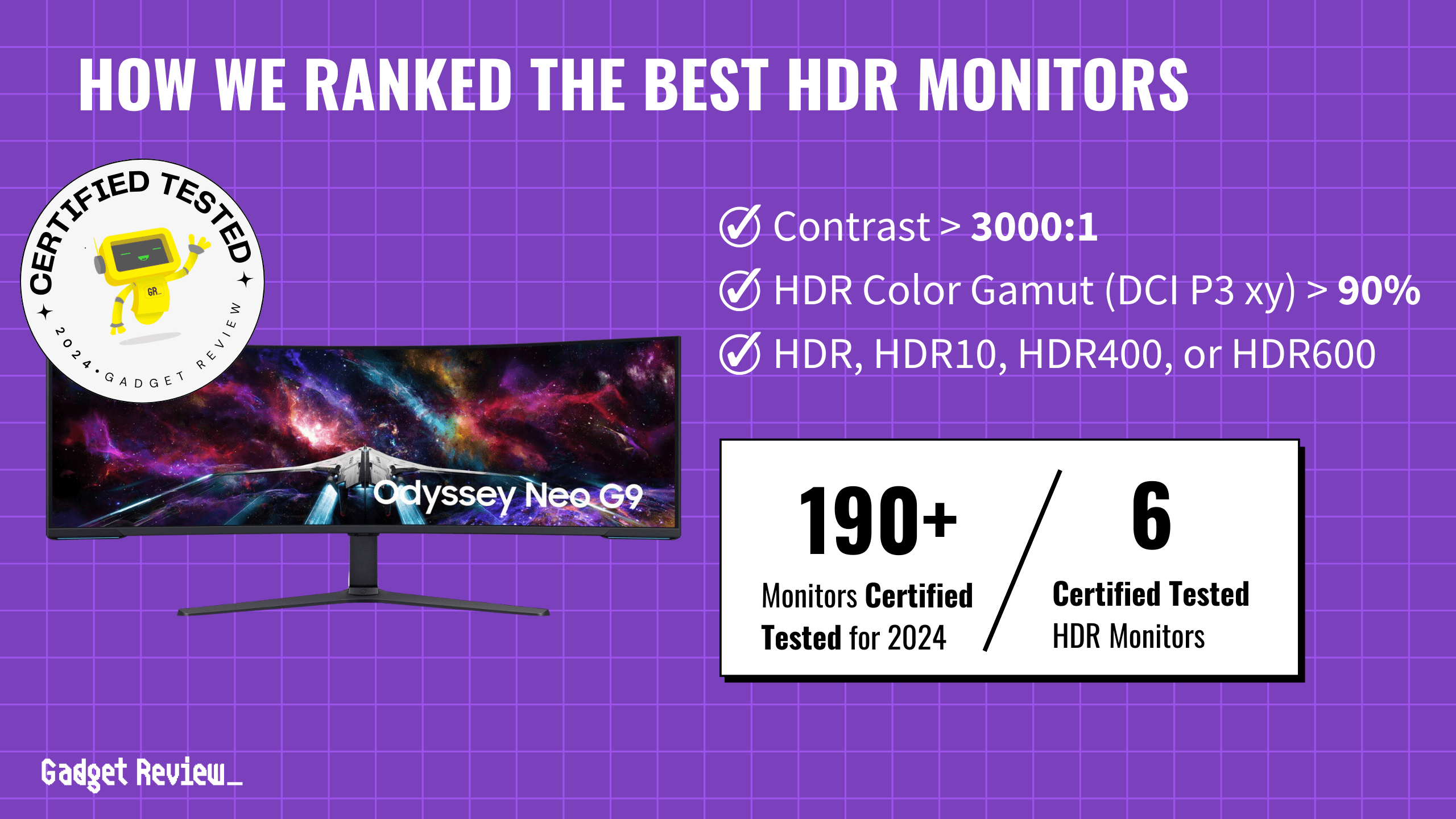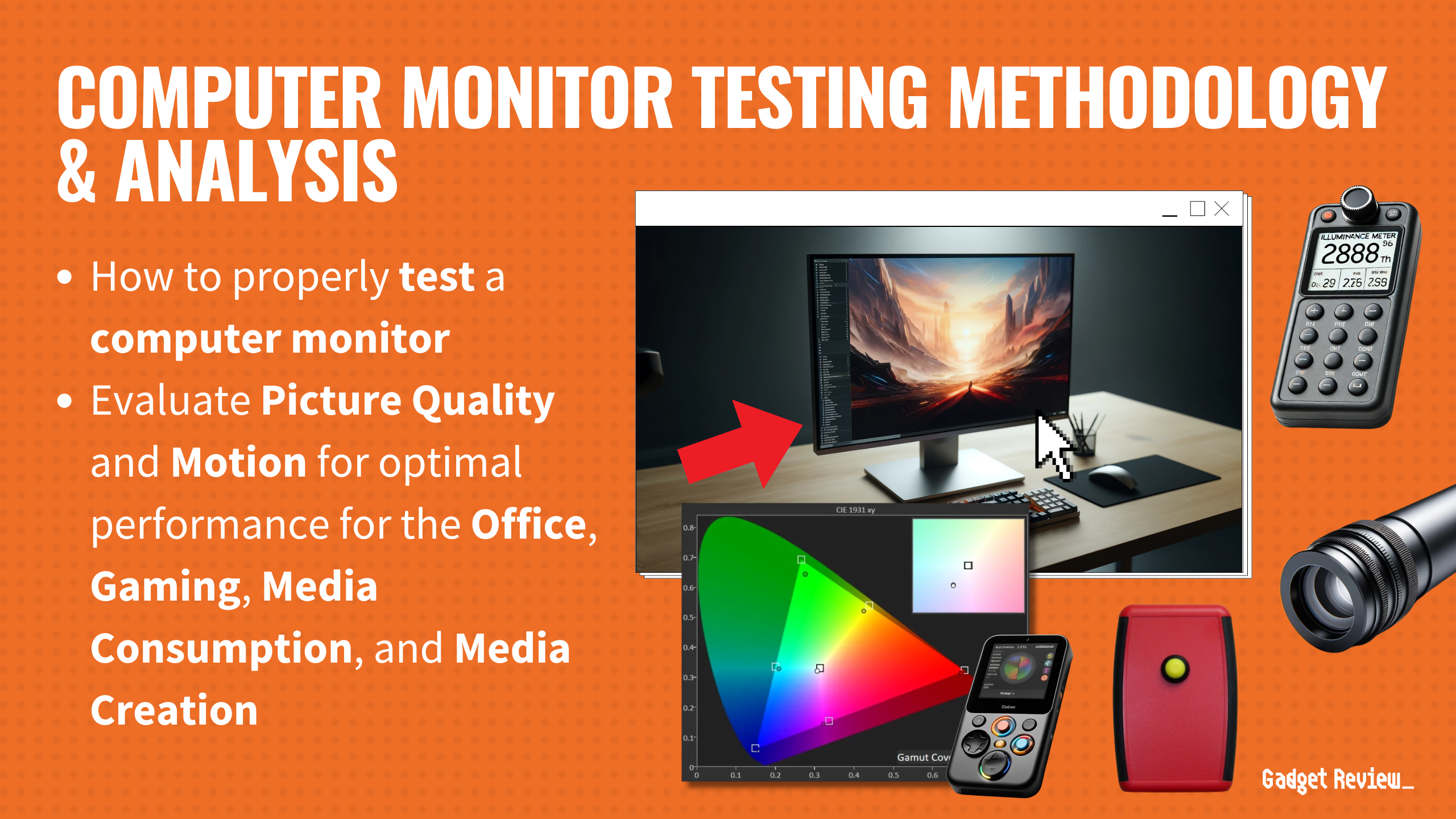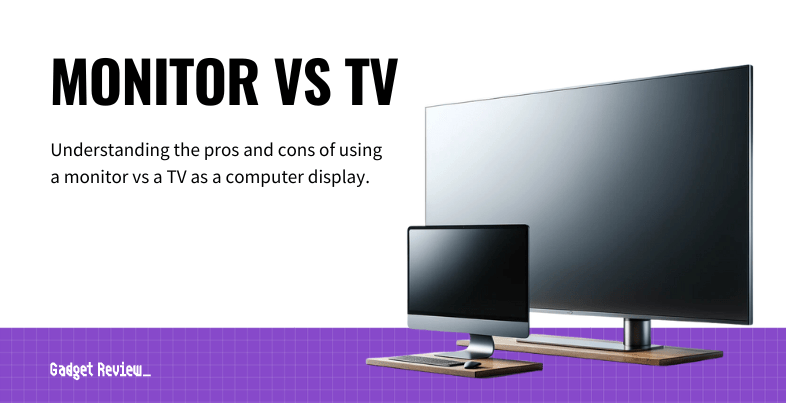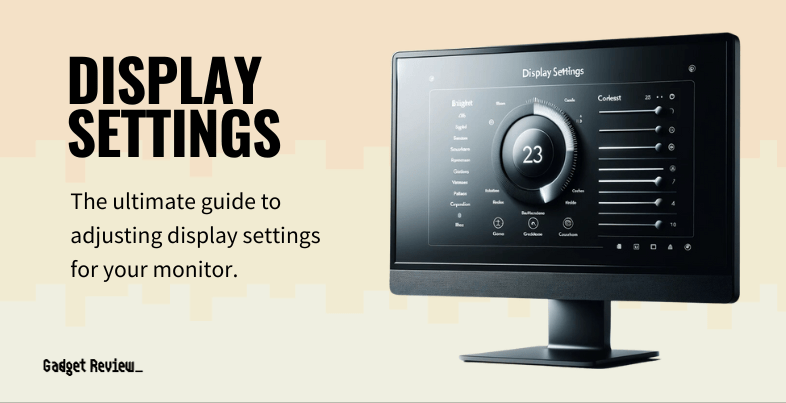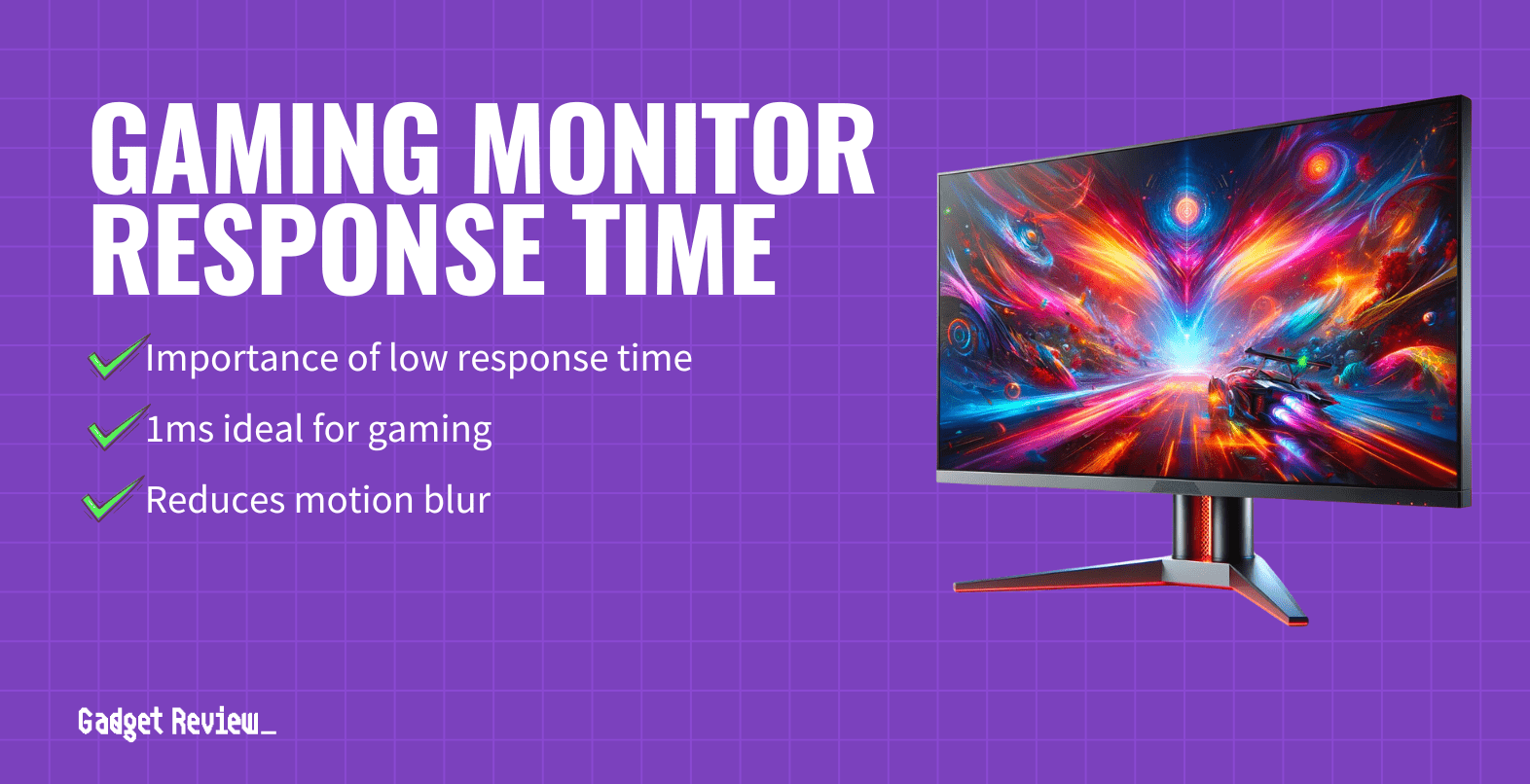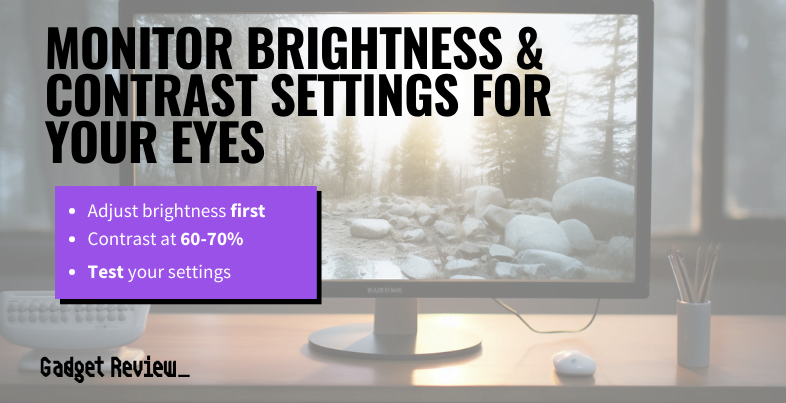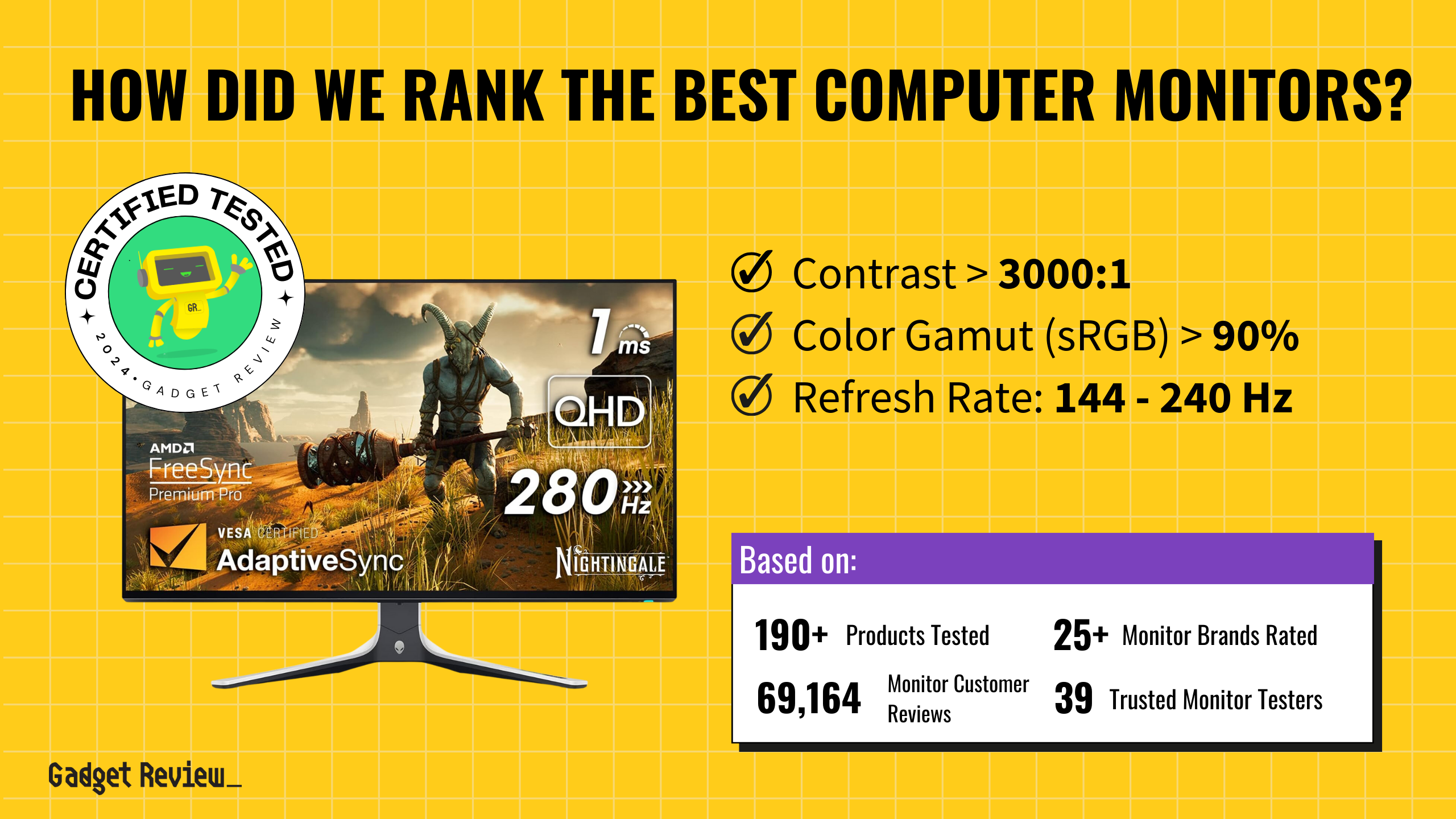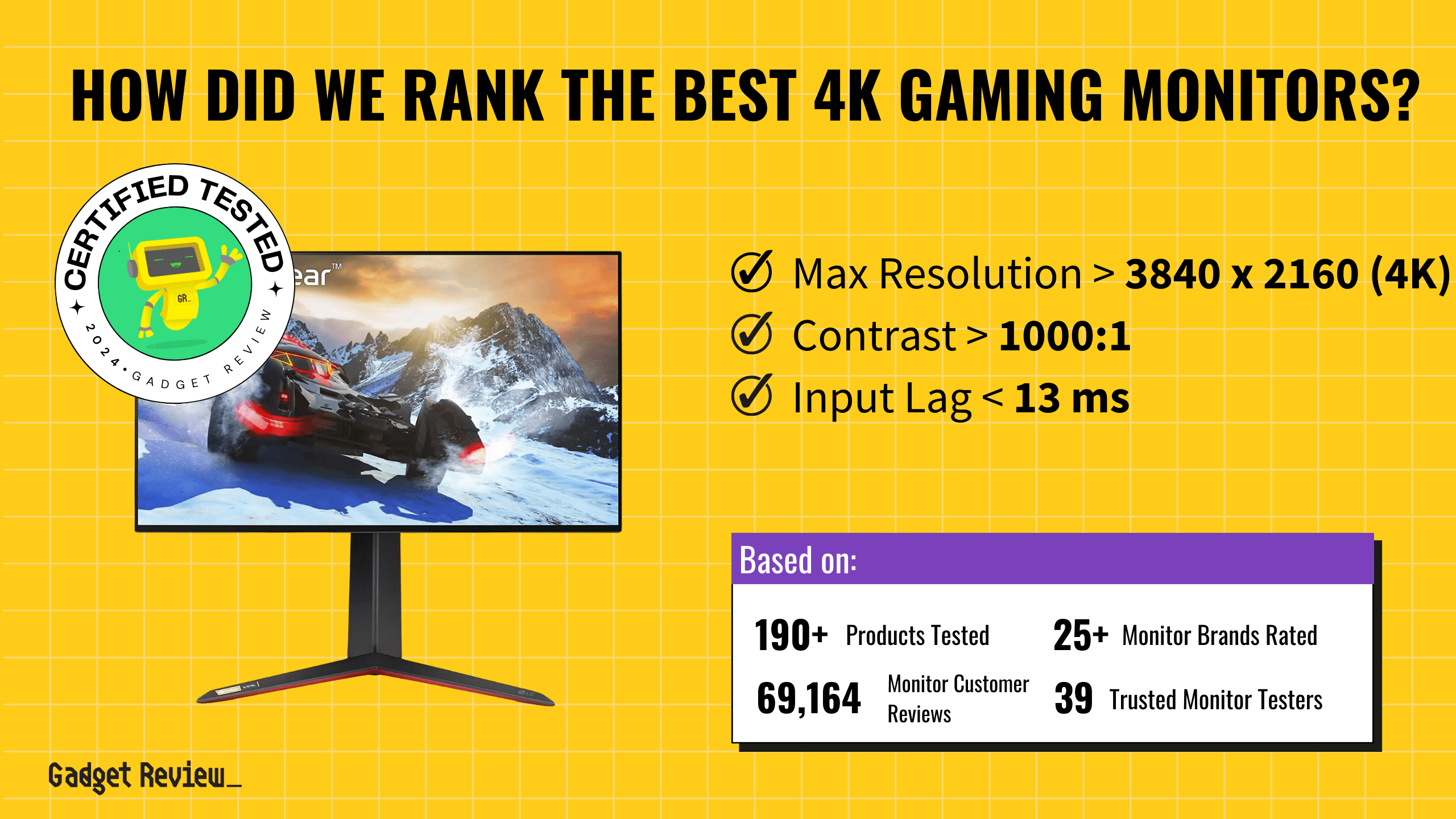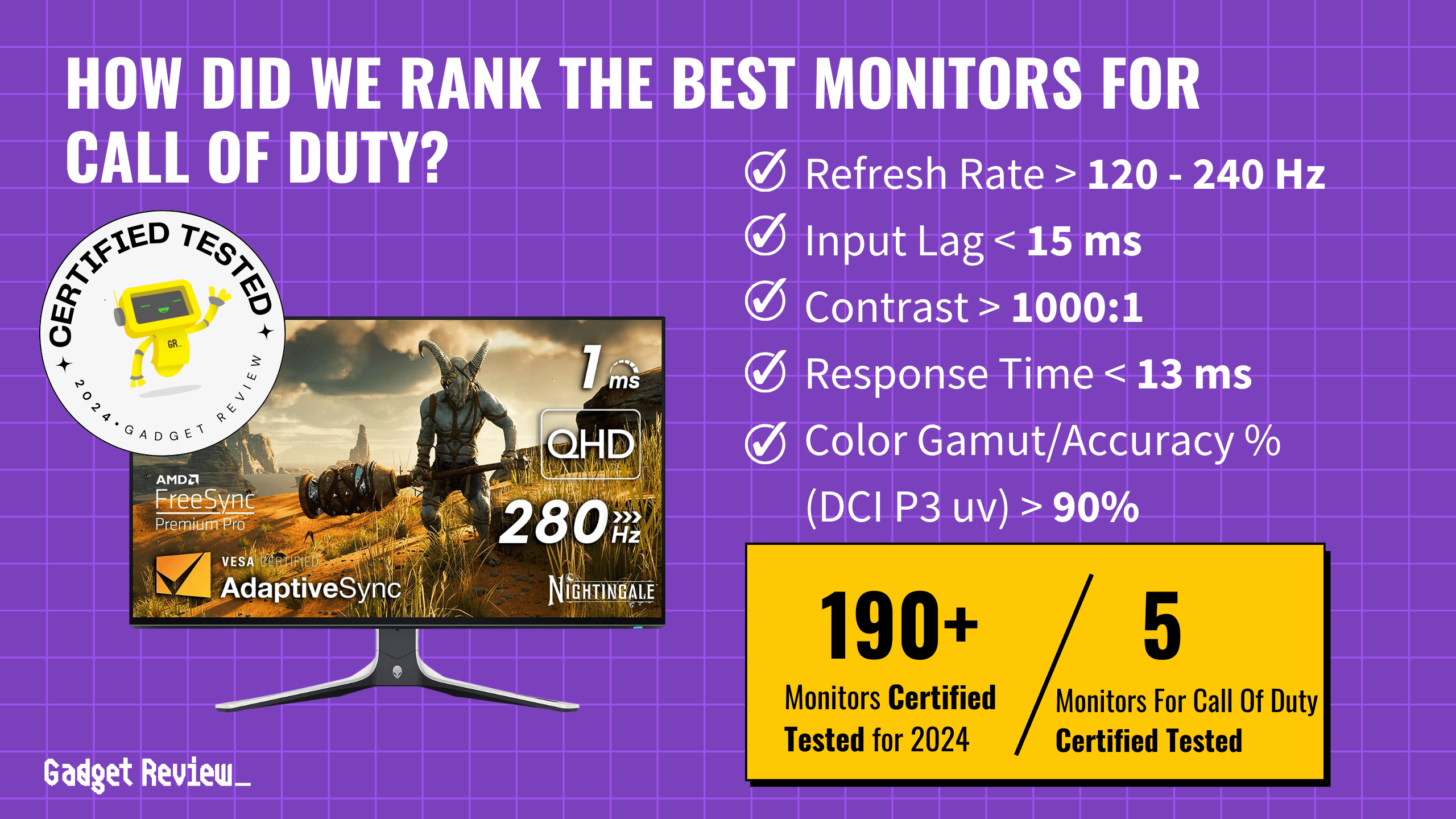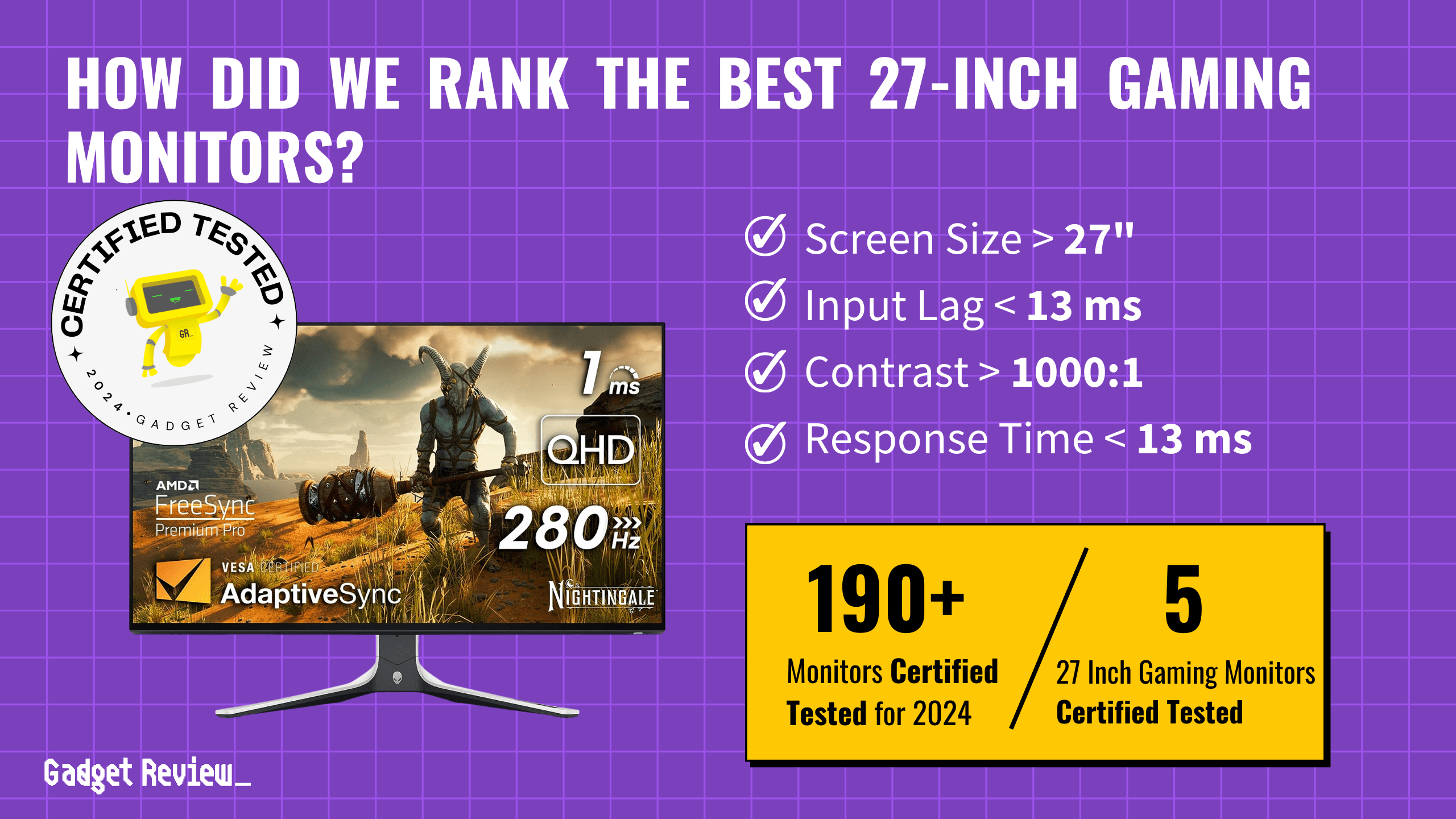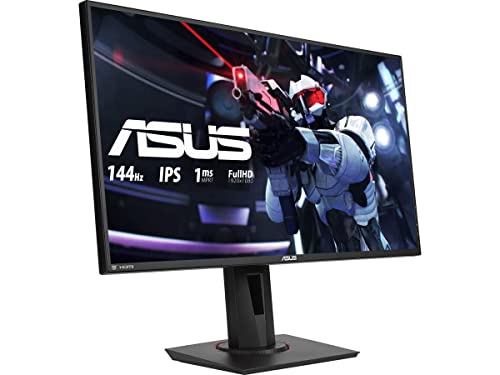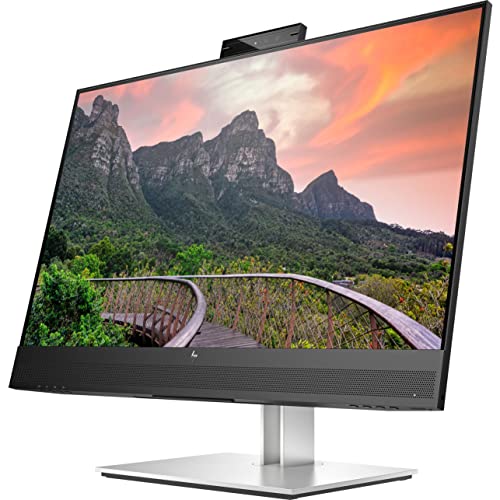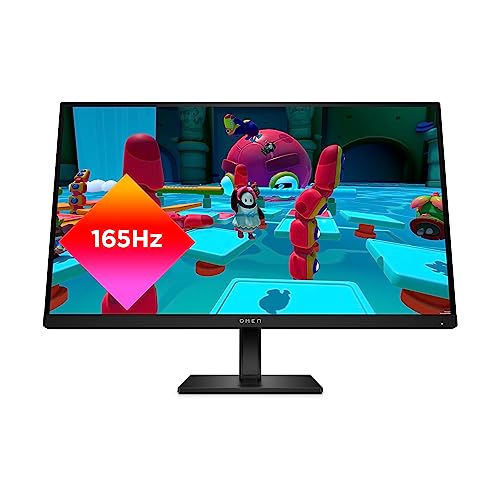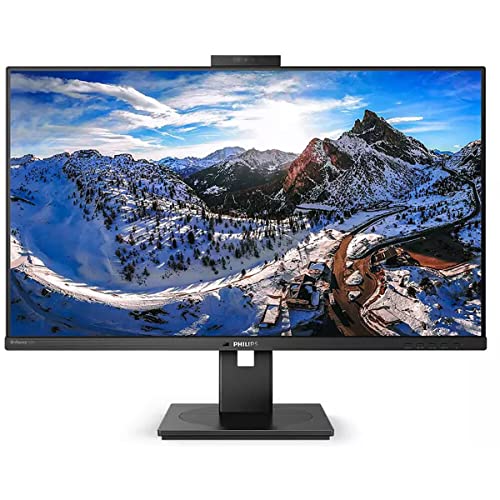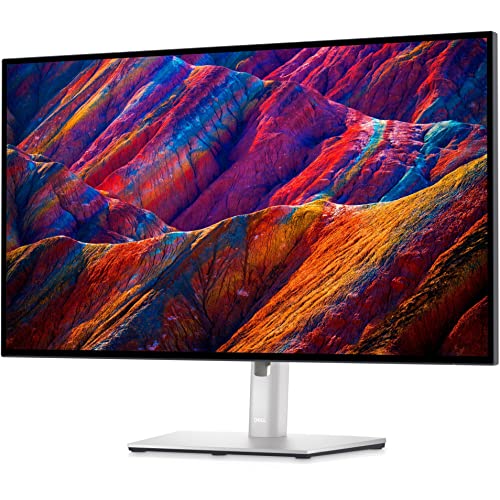Choosing the best HDR monitor means prioritizing contrast ratios, color gamut, and HDR brightness. HDR monitors need to excel in dynamic range, producing vivid, accurate colors, and handling different lighting conditions. Support for HDR10 or Dolby Vision, alongside low response times and input lag, ensures an immersive experience whether you’re gaming or working on graphic design.
After analyzing 196 monitors and certifying six as tested, we filtered through 320,301 reviews. With 71% of experts providing fake or unreliable reviews, our unique process using True Score and Trust Score guarantees only the best make our guide. The winning HDR monitors stood out for their outstanding image quality, responsive performance, and verified HDR capabilities. For those seeking exceptional overall quality, our guide also includes options for the best computer monitor overall, ensuring you have access to top-tier choices beyond just HDR capabilities.
How Did We Rank the Best HDR Monitors?
Our team at Gadget Review delved into over 200 sources, dissecting testing methodologies and user reviews to curate a definitive guide on the best HDR monitors. We assessed which factors truly matter by focusing on 2 required test results, 1 nice-to-have results, and 1 must-have specifications. By analyzing key pain points like brightness, color accuracy, and contrast ratios, our guide directs you to the best HDR monitors that deliver superior visual performance and value.
Our commitment to unbiased reviews is powered by our ‘True Score’ system, targeting low quality and fake reviews. When you shop through our links, you’re backing our mission. Dive deeper to see how.
Minimum Specifications
- Must support HDR format.
Test Criteria
- Contrast Ratio: 3,000:1 or higher, offering deep blacks and bright whites for an exceptional viewing experience.
- Color Accuracy: At least 90% of the DCI P3 color gamut, providing rich and vibrant colors.
“Nice To Haves”
- Fast Response Time: 10 ms or less, ensuring smooth transitions without motion blur.
Latest Updates
- 04/30/2024: Republished the list to include the best HDR monitors based on our True Score system.
Top HDR Monitors For 2025
Prices accurate at the time of publishing

Best Overall

Runner Up

Best Value

Best Budget

Best Mid-Range

Premium Pick
Corsair Xeneon 27QHD240
Best For Mac Mini
The Corsair Xeneon 27QHD240 is a fantastic HDR monitor with crisp, vibrant visuals with little glare, unmatched response time for blur-free images, and smooth transitions at a high refresh rate.
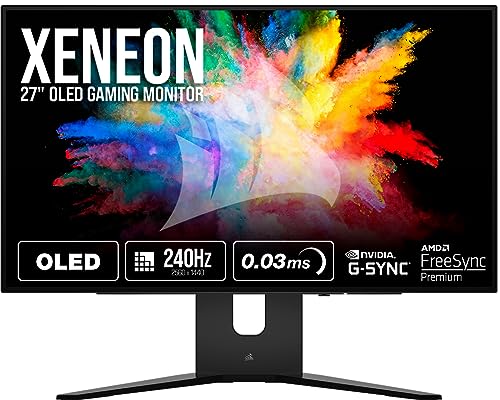
True Score
848410Experts
90336Customers
Absolutely Fresh
 $999.99
$999.99Read More
Snapshot
Reasons to Buy
- Excellent OLED Picture Quality
- Ultra-Fast Response Time
- Low Input Lag
- High Refresh Rate and VRR Support
Reasons to Avoid
- Lower Peak Brightness Levels
- Higher Input Lag with Different Refresh Rates
- Potential OLED Burn-In
Specifications

Available Inputs 3.5mm, DisplayPort, HDMI, USB 
Bluelight Filter Yes 
Built-In Speakers No 
Built-In Webcam No 
Curved Screen No Display Type OLED 
Flicker Free Yes HDMI Inputs 2 HDR Format HDR10 High Dynamic Range (HDR) Yes Max Resolution 2560 x 1440 
Panel Type OLED Refresh Rate 240 Hz 
Response Time 0.03 ms 
Rotating Screen Yes Screen size 27" 
Sync Technology AMD FreeSync, G-Sync All Specs
Test Results
Brightness (nits) 318 Contrast Ratio (as ratio, x:1) 9,473 Color Gamut/Accuracy % (DCI P3 xy) 96 Color Gamut/Accuracy % (DCI P3 uv) 0 Color Gamut % (Adobe RGB Coverage xy) 90 Color Gamut % (sRGB Coverage xy) 107 All Retailers
- $999.99
Availability
Free Shipping
Yes - $1,103.65
Availability
In StockFree Shipping
No Availability
Free Shipping
Our Verdict
The Corsair Xeneon 27QHD240 is an exceptional HDR monitor if you value crisp, vibrant, and precise visuals. Its best-in-class response time of 0.8 ms ensures blur-free images, which is crucial for HDR content that demands fluid motion. With a 240 Hz refresh rate, it provides smooth transitions, enhancing the HDR viewing experience. The monitor stands out in brightly lit environments with a superior anti-glare capability, thanks to a 1.8% reflection rate, ensuring consistent HDR quality without distractions. It has a 13.6 ms input lag, which is generally considered acceptable for most casual gaming and everyday computing tasks.
Boasting a DCI-P3 coverage of 96.10%, the Corsair Xeneon 27QHD240 reproduces a broad and accurate color spectrum, essential for HDR content where color fidelity is paramount. Its exceptional contrast ratio of 9473:1 enables it to deliver deep blacks and bright whites, enhancing the dynamic range that HDR content relies on. Although its brightness of 317 nits suits most indoor settings, its performance in direct sunlight may not match that of monitors like the Gigabyte Aorus FV43U, yet it compensates with superior contrast and color accuracy.
If you’re a professional looking for an HDR monitor for productivity tasks, even though it lacks built-in speakers, its premium qualities are fantastic, including OLED technology for vibrant colors and profound black levels. Despite a higher price, the Corsair Xeneon 27QHD240’s blend of high refresh rate, low reflectivity, and outstanding color and contrast makes it a valuable investment if you’re dedicated to HDR content creation and consumption.
Read Less

Best Overall

Runner Up

Best Value

Best Budget

Best Mid-Range

Premium Pick
Dell Alienware AW3423DW
Best For Macbook Pro
The Dell Alienware AW3423DW excels for HDR content in graphic design and video editing, offering superb color accuracy and minimal glare, though its modest brightness suits indoor use.
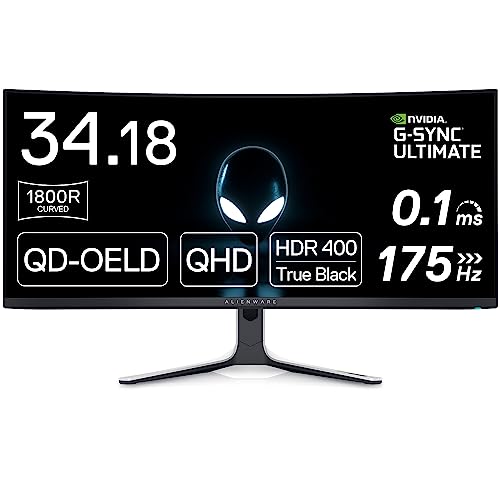
True Score
838514Experts
862kCustomers
Absolutely Fresh
 $749.95
$749.95Read More
Snapshot
Reasons to Buy
- Spectacular image quality
- Ultra-fast response time
- Low Input lag
- High native refresh rate
Reasons to Avoid
- Bright surroundings reduce black levels
- Not suited for gaming consoles
Specifications

Aspect Ratio 21:9 
Available Inputs 3.5mm, DisplayPort, HDMI, USB 
Bluelight Filter Yes 
Built-In Speakers No 
Built-In Webcam No 
Curved Screen Yes Display Type OLED 
Flicker Free Yes HDMI Inputs 1 HDR Format HDR10, HDR400 High Dynamic Range (HDR) Yes Max Resolution 3440 × 1440 
Panel Type n/a Refresh Rate 165 Hz 
Response Time 0.1 ms 
Rotating Screen No Screen size 34" 
Sync Technology AMD FreeSync Premium Pro, G-Sync Ultimate All Specs
Test Results
Brightness (nits) 241 Contrast Ratio (as ratio, x:1) 0 Color Gamut/Accuracy % (DCI P3 xy) 100 Color Gamut/Accuracy % (DCI P3 uv) 0 Color Gamut % (Adobe RGB Coverage xy) 96 Color Gamut % (sRGB Coverage xy) 100 All Retailers
- $749.95
Availability
In StockFree Shipping
No - $914.95
Availability
In StockFree Shipping
No
Our Verdict
If you prefer an HDR display with precise colors and minimal glare, the Dell Alienware AW3423DW is an impressive option. Its low reflectivity of 1.4% ensures minimal distraction from reflections, which is essential in brightly lit environments for HDR content. While its brightness of 241.39 nits might seem modest, it’s adequate for indoor use, particularly when considering HDR’s dynamic range requirements.
The monitor’s exceptional DCI P3 color gamut coverage of 99.80% provides near-perfect color accuracy, crucial for HDR content that demands a wide color range. Thanks to OLED technology, its infinite contrast ratio ensures deep blacks and vivid details in dark scenes. Despite a refresh rate lower than some competitors, its performance in color depth and contrast makes it a prime choice for HDR content. Compared to the Samsung Odyssey Neo G9, the Neo G9 has superior brightness that can handle direct sunlight, but the AW3423DW is better for color-critical tasks and reducing reflection glare.
With a high input lag of 20.5 ms, it may not be the first choice for competitive gaming, but its fast response time of 2.0 ms minimizes motion blur, benefiting fast-paced HDR games and video playback. The lack of built-in speakers is a minor compromise that’s offset its superior visual performance.
Given its strengths in color accuracy, contrast, and glare management, the AW3423DW’s input lag and brightness compromises are minor compared to its benefits for HDR content. Thus, it is a valuable pick for professionals and enthusiasts who prioritize a high-quality HDR display.
Read Less

Best Overall

Runner Up

Best Value

Best Budget

Best Mid-Range

Premium Pick
Samsung Odyssey G85SB
Best For Video Editing
The Samsung Odyssey G85SB is best for indoor work and those who want crisp, colorful HDR content. Its unparalleled color gamut coverage, great contrast, and glare management make it ideal for this type of work.
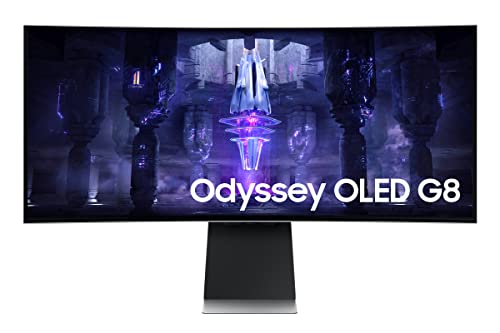
True Score
828310Experts
878kCustomers
Absolutely Fresh
 $449.95
$449.95Read More
Snapshot
Reasons to Buy
- Great image quality
- Fast response time
- Low input lag
- Outstanding refresh rate
Reasons to Avoid
- Low peak brightness
- Subpar ergonomics
Specifications

Aspect Ratio 21:9 
Available Inputs HDMI, USB 
Bluelight Filter Yes 
Built-In Speakers Yes 
Built-In Webcam No 
Curved Screen Yes Display Type OLED 
Flicker Free Yes HDMI Inputs 1 HDR Format HDR10, HDR10+, HDR10+ Gaming, HDR400 High Dynamic Range (HDR) Yes Max Resolution 3440 × 1440 
Panel Type n/a Refresh Rate 175 hz 
Response Time 0.1 ms 
Rotating Screen No Screen size 34" 
Sync Technology AMD FreeSync Premium Pro All Specs
Test Results
Brightness (nits) 237 Contrast Ratio (as ratio, x:1) 0 Color Gamut/Accuracy % (DCI P3 xy) 110 Color Gamut/Accuracy % (DCI P3 uv) 0 Color Gamut % (Adobe RGB Coverage xy) 96 Color Gamut % (sRGB Coverage xy) 141 All Retailers
- $449.95
Availability
In StockFree Shipping
- $648.99$1,200Save $551
Availability
Free Shipping
No - $999.99$1,200Save $200
Availability
In StockFree Shipping
No - $1,049.99$1,200Save $150
Availability
In StockFree Shipping
No
Our Verdict
If crisp and colorful content is important to you, the Samsung Odyssey G85SB is an exceptional monitor. It has a best-in-class color gamut coverage of 109.6% DCI P3 and 141.30% sRGB, outperforming even the Odyssey Neo G9. This means the display can reproduce a wide range of colors, leading to more vibrant and detailed images, which is ideal for professional photo and video editing, graphic design, and media consumption.
The G85SB’s brightness of 237.45 nits is suitable for most home office or business environments with limited natural light. It provides clear visibility without being overly bright. The G85SB’s OLED display technology offers true blacks and a wide color range, enhancing visual experiences for all types of content. Its best-in-class reflective rate of 1.4% reduces glare and maintains image clarity in bright rooms.
It provides a smooth visual experience aided by a high refresh rate of 175 Hz. Its good response time of 3.45 ms and input lag of 13.4 ms will make fast-paced applications and video games smoother and more immersive. Built-in speakers and a curved screen make the display more immersive.
This is a reliable investment if you’re a professional or monitor enthusiast wanting a colorful display for creative work or media consumption while working indoors. The compromise is the high price and that it’s not the brightest monitor on the list that can tackle direct sunlight, but that’s balanced out by its unbeatable range of colors and glare reduction.
Read Less

Did you know 71% of computer monitor reviewers are untrustworthy?
Our research found only 33 of 110+ computer monitor reviewers as of December 2025 can be trusted. This is why Gadget Review is committed to calculating the most accurate product scores on the web.
To do this, we give every computer monitor review site a Trust Rating, which measures how trustworthy the site and their testing claims are. We then leverage AI & a machine learning model to combine and calculate the Trust Rating with data from experts and consumers to deliver the True Score, the web’s most accurate product quality rating.
 320,301
320,301Monitor Reviews Analyzed

196
Total Products Analyzed

Best Overall

Runner Up

Best Value

Best Budget

Best Mid-Range

Premium Pick
Samsung Odyssey Neo G9
Best For Streaming
The Samsung Odyssey Neo G9 excels for HDR content with its vibrant display and deep blacks, offering superior brightness and high contrast for an immersive experience at a premium price.
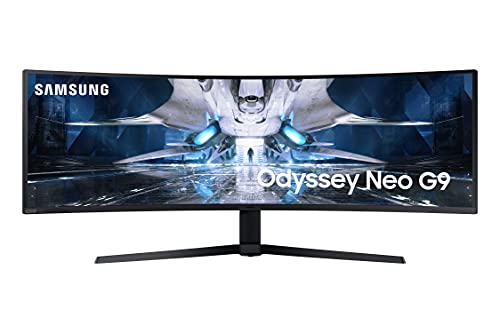
True Score
81814Experts
853kCustomers
Absolutely Fresh
 SAVE $900$2,499.99$1,599.99
SAVE $900$2,499.99$1,599.99Read More
Snapshot
Reasons to Buy
- Outstanding 240Hz maximum refresh rate
- Advanced Mini LED local dimming
- HDMI 2.1 inputs
- Excellent color gamut
- Outstanding 5120 x 1440 screen resolution
Reasons to Avoid
- Overly aggressive screen curvature
- Narrow viewing angles
- Variable refresh rate (VRR) issues at 60Hz
Specifications

Curved Screen Yes Display Type VA HDMI Inputs 2 HDR Format Yes Max Resolution 5120 x 1440 
Panel Type VA Refresh Rate 240 Hz 
Response Time 1 ms Screen size 49" 
Sync Technology AMD FreeSync All Specs
Test Results
Brightness (nits) 628 Contrast Ratio (as ratio, x:1) 4,692 Color Gamut/Accuracy % (DCI P3 xy) 91 Color Gamut/Accuracy % (DCI P3 uv) 0 Color Gamut % (Adobe RGB Coverage xy) 86 Color Gamut % (sRGB Coverage xy) 100 All Retailers
- $1,599.99$2,500Save $900
Availability
In StockFree Shipping
No - $1,599.99$2,500Save $900
Availability
In StockFree Shipping
- $1,689.99$3,033Save $1,343
Availability
In StockFree Shipping
No - $2,199.99
Availability
In StockFree Shipping
No
Our Verdict
If you’re an HDR enthusiast seeking a monitor that excels in delivering vibrant content, the Samsung Odyssey Neo G9 has exceptional brightness of 628.33 nits and a high contrast ratio of 4692:1, ensuring deep blacks and vibrant colors for a truly immersive HDR experience. With a color gamut coverage of 91% DCI P3, it accurately displays a wide range of colors, making it perfect for color-critical tasks and HDR gaming, where color precision is paramount. Although it has a reflection rate of 5.4%, its superior brightness effectively counteracts glare, maintaining clear visibility even in brightly lit environments.
The monitor’s best-in-class low input lag of 8.9 ms and a swift response time of 2.7 ms guarantees responsive gameplay and smooth transitions, crucial for fast-paced HDR content and competitive gaming. Its 240 Hz refresh rate and AMD FreeSync technology support further enhance the gaming experience, offering fluid motion and eliminating screen tearing in HDR games. The max resolution of 5120 x 1440 means it’s an ultra-wide screen format, providing a vast display area with a very high level of detail. It’s equipped with a Vertical Alignment (VA) panel that offers deep blacks, high contrast ratios, and wide viewing angles. It is a great choice for gaming and professional use where image depth and detail are valued.
Despite a premium price, the Samsung Odyssey Neo G9 represents excellent value for those prioritizing HDR performance. It combines high brightness, strong contrast, and accurate colors with gaming-centric features, making it an outstanding option for gamers and professionals alike who require a monitor capable of handling HDR content.
Read Less

DON’T SEE WHAT YOU’RE LOOKING FOR?
For those wondering what a 4K monitor is, it’s a display with a resolution four times that of standard 1080p, providing incredibly sharp images. When comparing 2K vs 4K monitors, the best 4K monitors and top 4K gaming monitors are designed for users seeking unparalleled clarity and detail. Additionally, gaming monitor response time significantly affects gameplay smoothness, making it a critical feature in gaming monitors.
Regarding brand-specific offerings, the best ASUS monitor and top Acer monitor cater to various needs from professional to personal use. The ASUS ProArt PA148CTV highlights a model that is an excellent portable choice for creatives, while the top photo editing monitors offer precise color accuracy and consistency.


Best Overall

Runner Up

Best Value

Best Budget

Best Mid-Range

Premium Pick
Gigabyte Aorus FV43U
Best For Photo Editing
Ideal for bright rooms, the Gigabyte Aorus FV43U has unparalleled brightness and supports a 144 Hz refresh rate for smooth motion. It offers decent contrast and excels in color accuracy, though reflections and input lag could be better.
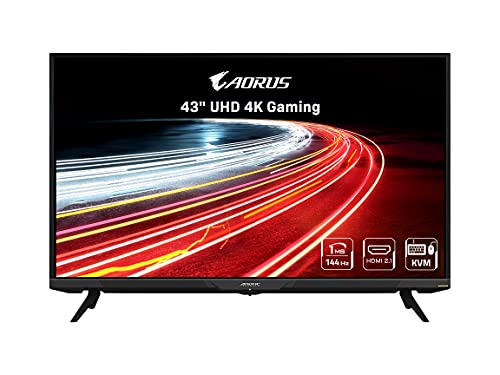
True Score
78784Experts
84637Customers
Mixed Reviews
 $749.99
$749.99Read More
Snapshot
Reasons to Buy
- Great contrast ratio
- High 144Hz refresh rate
- Sharp picture quality
- Low input lag
- High color accuracy
Reasons to Avoid
- Poor ergonomics
- Narrow viewing angles
- Bad local dimming feature
Specifications
Display Type VA HDMI Inputs 2 HDR Format Yes Max Resolution 3840 x 2160 (4k) 
Panel Type VA Refresh Rate 144 Hz 
Response Time 1 ms Screen size 43" 
Sync Technology AMD FreeSync, G-Sync All Specs
Test Results
Brightness (nits) 904 Contrast Ratio (as ratio, x:1) 4,982 Color Gamut/Accuracy % (DCI P3 xy) 99 Color Gamut/Accuracy % (DCI P3 uv) 150 Color Gamut % (Adobe RGB Coverage xy) 98 Color Gamut % (sRGB Coverage xy) 99 All Retailers
- $749.99
Availability
In StockFree Shipping
Yes - $749.99$1,528Save $778
Availability
In StockFree Shipping
No - $749.99$800Save $50
Availability
In StockFree Shipping
Our Verdict
If you need to set up your monitor in a bright room, the Gigabyte Aorus FV43U, with its best-in-class brightness of 904.5 nits, is a superb choice. Additionally, this monitor supports a high refresh rate of 144 Hz for smoother motion and reduced eye strain, especially for competitive gamers. Its response time of 3.93 ms is quick enough to handle motion without significant blur, making it decent for gaming and video playback.
The FV43U falls slightly short in terms of contrast ratio compared to the FO48U OLED, registering at 4981.65:1 as opposed to the OLED’s impressive 135,000:1. However, it’s important to note that this monitor still delivers good contrast performance for a VA panel. This monitor does have superior coverage of 99.43% DCI P3, ensuring precise color reproduction ideal for work needing color precision.
The FV43U has a high reflection percentage of 5.4%, which may hinder performance in brightly lit environments. However, the input lag of 21.7 ms is reasonable for casual gaming, but competitive gamers might find it inadequate.
In terms of value, the FV43U offers impressive features at a reasonable price. It’s worth noting that it lacks certain additional features like built-in speakers, a curved screen, and ergonomic adjustments, but if brightness and color accuracy are your primary concerns, this monitor is an excellent choice. Whether you’re a casual gamer or someone who values a wide range of color reproduction for graphic work, the Gigabyte Aorus FV43U provides an impressive balance of performance and value.
Read Less
Category Snapshot
Computer Monitors
- Total Brands/Products Tested
27 Brands, 196 Products
- Top 2 Brands
Dell, HP
- Price Range (Budget-Premium)
$100-$1,500
- Average True Score
74.46
- Important Test Criteria
Brightness (cd/m2)
Contrast Ratio (1000:1) - Most Trusted Testers

- Top Monitor Experts
- Typical Warranty
2 years
- Covered by Insurance
Yes – AKKO

Best Overall

Runner Up

Best Value

Best Budget

Best Mid-Range

Premium Pick
Gigabyte Aorus FO48U OLED
The Gigabyte Aorus FO48U OLED stands out for productivity and premium HDR with its impressive contrast and handling ambient light well with a best-in-class reflective rate.
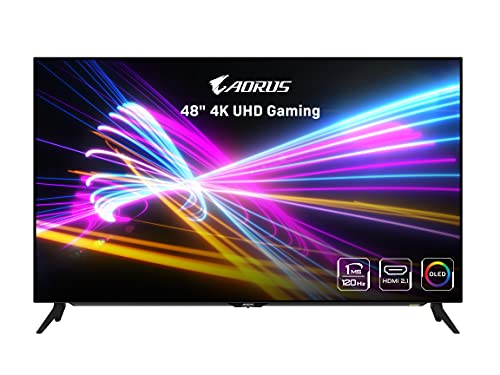
True Score
78784Experts
83203Customers
Mixed Reviews
 $1,243.25
$1,243.25Read More
Snapshot
Reasons to Buy
- Dual HDMI 2.1 ports for modern console gaming
- Wide viewing angles
- Great build quality
- Impressive reflection handling
- High refresh rate
Reasons to Avoid
- Poor HDR brightness levels
- No ergonomics
- No cable management
Specifications
Display Type OLED HDMI Inputs 2 HDR Format Yes Max Resolution 3840 x 2160 (4k) 
Panel Type OLED Refresh Rate 120 Hz 
Response Time 1 ms Screen size 48" 
Sync Technology AMD FreeSync, G-Sync All Specs
Test Results
Brightness (nits) 282 Contrast Ratio (as ratio, x:1) 135k Color Gamut/Accuracy % (DCI P3 xy) 95 Color Gamut/Accuracy % (DCI P3 uv) 130 Color Gamut % (Adobe RGB Coverage xy) 87 Color Gamut % (sRGB Coverage xy) 100 All Retailers
- $1,243.25
Availability
In StockFree Shipping
Yes
Our Verdict
If you want a monitor that excels in productivity tasks, offers a premium HDR experience, and provides a wide color gamut, the Gigabyte Aorus FO48U OLED is an exceptional consideration. This monitor is focused on delivering high-quality HDR experiences, boasting an impressive contrast ratio of 135,000:1, essential for deep blacks and bright whites in HDR content. Thanks to its best-in-class reflective rate of 1.3%, it performs well in rooms with ambient light.
The FO48U OLED, with an input lag of 19.4 ms and a response time of 3.2 ms, provides a crisp and blur-free content display. Although its brightness of 282.3 nits may not be the brightest, it does not detract from the overall quality. Its good color gamut coverage of 94.82% DCI P3 ensures a wide range of colors are accurately represented, making it an excellent choice for color-sensitive work and HDR content.
When compared to its sibling, the Gigabyte Aorus FV43U, the FO48U OLED has a lower brightness but a significantly higher contrast ratio, making it superior for HDR content. The monitor also supports FreeSync, which helps eliminate screen tearing and stuttering during video playback, enhancing your viewing experience. However, it may not be as versatile for some users due to the lack of built-in speakers, a curved screen, and other ergonomic features like a rotating screen, blue light filter, and flicker-free technology.
Despite having a high upfront cost, lack of ergonomic features, and lack of built-in speakers, it offers excellent value, especially if you want an HDR experience with minimal glare and a wide color gamut. Its features, superb contrast ratio, and decent brightness make it a strong contender on our list.
Read Less
Which Criteria Matters for Testing Best HDR Monitors?
By focusing on these criteria (2 required, 1 nice to have), anyone can quickly and easily compare these computer monitors and how they’ll perform. This helps you make an informed decision and purchase the best HDR monitor
| CRITERIA | RANGE | REQUIRED | DEFINITION |
|---|---|---|---|
| Contrast Ratio | >3000:1 | Yes | The difference in brightness between the whites (lit sections) and blacks (dim or unlit sections) of a monitor panel. |
| Color Gamut (DCI P3 xy) | > 90% | Yes | How much of the DCI P3 xy color gamut is covered by the monitor, which helps indicate color accuracy for HDR content, which includes certain movies. |
| Response Time | < 10 ms | No (Nice to have) | The time it takes for a pixel to change from one color to another. |
Our Trusted Data Sources
We looked at 110+ computer monitor reviewers and found that 33 are trustworthy (60%+ Trust Rating). The three we have listed below are our most trusted for computer monitors.
- Samuel Breton – Rtings, MuckRack
- Chris Eberle – Tom’s Hardware, LinkedIn
- Tony Hoffman – PC Mag, MuckRack
Interested in a comprehensive analysis of our data sources? We’ve got you covered. Below, you’ll find a detailed list of every computer monitor review website we’ve identified, organized by their respective Trust Ratings from highest to lowest. But we didn’t stop there. We’ve meticulously reviewed each publication and verified the data by checking whether the authors have bio links to MuckRack or LinkedIn. We’re committed to not only checking the facts but ensuring their veracity.
Computer Monitor Test Data & Results
1. Contrast Ratio (as ratio, x:1) Test Results
Contrast Ratio
> 3000:1
Acceptable range of performance
Definition: How bright the monitor will get, usually under specific testing conditions, like 10% windows (which means 10% of the screen is a white box.)
Units of Measurement: Ratio
Tools to Measure: Luminance meter or photometer or colorimeter
Why It’s Important:
Contrast ratio is how dynamic images are given detail and dramatic effect, with very dark areas appearing truly dark, while bright areas are bright and pop.
Contrast ratio is responsible for making images appear “dynamic” and “dramatic.” By having a good contrast ratio, a monitor is able to recreate dramatic differences between light and dark spots in scenes, images and games accurately.
At a minimum, we recommend a contrast ratio of 1000:1, as this will do a good enough job at allow for detail in dark scenes and images. If contrast ratio gets too low, the picture quality suffers, and the monitor performs worse across the board, no matter the lighting condition. By getting a monitor with a sufficiently high contrast ratio, you can ensure the picture quality doesn’t suffer, and dramatic scenes with stark shifts in lighting, whether they be in games or videos, are created as accurately as possible.
Contrast Ratio (higher is better)
2. Color Gamut/Accuracy % (DCI P3 xy) Test Results
Color gamut is responsible for making a monitor produce accurate colors when displaying a variety of content. The DCI P3 xy gamut is considered a “standard” gamut of sorts, and is used to help color grade films. Most HDR content will use this gamut at the very least (though other gamut exist) and it’s a commonly used gamut for films.
When it comes to a computer monitor, having a panel that covers at least 90% of the DCI P3 gamut means it’ll output accurate colors when watching HDR content and movies that use the gamut. If a monitor doesn’t cover enough of the gamut, it causes color inaccuracies and shifts the image quality. If you care about maintaining accuracy in the movies you watch so they look the way they were intended, this gamut needs to be properly covered.
Color Gamut/Accuracy % (DCI P3 xy)
> 90%
Acceptable range of performance
Definition: The amount of the DCI P3 xy gamut that the monitor covers.
Units of Measurement: %
Tools to Measure: Colorimeter
Why It’s Important:
Color gamut coverage is important for ensuring that a monitor is able to accurately output colors. The DCI P3 xy gamut is responsible for making movies and HDR content look the way they were intended.
Color Gamut P3 XY (in %; higher is better)
3. Response Time (ms) Test Results
Response Time (ms)
< 10 ms
Acceptable range of performance
Definition: The amount of time it takes for pixels on a monitor to shift from one color to another.
Units of Measurement: Milliseconds (ms)
Tools to Measure: Response time tool, camera
Why It’s Important:
Faster response times keep the screen from becoming muddied and blurred when fast-paced action scenes in movies or games start.
Response time measures how long it takes pixels to change from one color to another, often gray to gray. Low response times means the monitor is able to keep up with constant shifts in colors, and helps prevent motion blur from being introduced whatever you’re watching.
We generally recommend a response time that is 10 ms or less, as this will keep motion blur to a minimum, but if you don’t watch a lot of very high intensity videos or play fast-paced games, response time isn’t going to matter much. It’s important to note that monitors will often advertise a 1ms or 2ms or 5ms response time, to name a few, but response time tests measure full color to color shifts, as well as overshoots, which produces different times than what the monitor often claims on the box. This is why response time is a listed spec, but also a testable criterion.
Response Time (in ms; lower is better)
Best HDR Monitors: Mistakes To Avoid
- Neglecting Local Dimming: Not evaluating the presence and effectiveness of local dimming technology can lead to purchasing a monitor with inferior HDR performance, as local dimming enhances contrast by adjusting backlighting for darker blacks and brighter whites. For example, the HP U28 4K HDR has limited HDR performance due to the absence of local dimming, resulting in a lower contrast ratio.
- Underestimating Peak Brightness: Overlooking peak brightness levels can result in a monitor that lacks the necessary brightness to display HDR content effectively, diminishing the impact of highlights and reducing overall HDR visual fidelity. Additionally, a strong contrast ratio enhances the depth of blacks and the purity of whites, further amplifying HDR performance and creating a more immersive viewing experience.
- Disregarding Panel Type: Failing to consider panel type (e.g., IPS, VA, or TN) can result in choosing a monitor with limited color accuracy or poor contrast, impacting the HDR viewing experience and overall picture quality. Understanding the different monitor display types is crucial, as each type offers unique benefits and drawbacks in terms of color reproduction, viewing angles, and response times, which can significantly affect your satisfaction with the display’s performance.
- Ignoring Connectivity: Failing to consider connectivity options such as HDMI 2.1 or DisplayPort 1.4 can limit your monitor’s compatibility with HDR content sources like gaming consoles or high-end graphics cards, potentially restricting your ability to fully utilize its HDR capabilities. For those looking to connect to specific devices, the leading gaming monitors for PS4 and Mac Mini feature optimized ports and settings that ensure compatibility and maximize performance, ensuring a seamless and high-quality gaming or computing experience.
The Best HDR Monitors Tests Compared
Product |
True Score
|
Brightness
|
Contrast Ratio
|
Color Gamut (DCI P3)
|
Color Gamut (sRGB)
|
Input Lag (ms)
|
Response Time (ms)
|
Reflections % | |
|---|---|---|---|---|---|---|---|---|---|
| 84 |
|
|
|
|
|
|
| $999.99 |
| 83 |
|
|
|
|
|
|
| $749.95 |
| 82 |
|
|
|
|
|
|
| $449.95 |
| 81 |
|
|
|
|
|
|
| $1,599.99 $2,500 $900 |
| 78 |
|
|
|
|
|
|
| $749.99 |
| 78 |
|
|
|
|
|
|
| $1,243.25 |


